Frogs can be found in almost every semiaquatic habitat on earth. If you’re enjoying the calm breeze of Illinois and happen to see a tree frog on a nearby branch, let’s say it’s a normal occurrence. Due to its size and central location in the United States, Illinois houses a rich variety of amphibians.
There are 41 different species of amphibians in Illinois alone. Among all the different amphibians, a few species, such as the Bird-voiced Tree Frog, Spring Peeper, Western Chorus Frog, and many others, belong to the tree frog family.
Now let’s get to know about all the tree frogs in Illinois. Additionally, we’ll look at their diets, habitats, distinguishing features, calls, and breeding habits.
Are there tree frogs in Illinois?
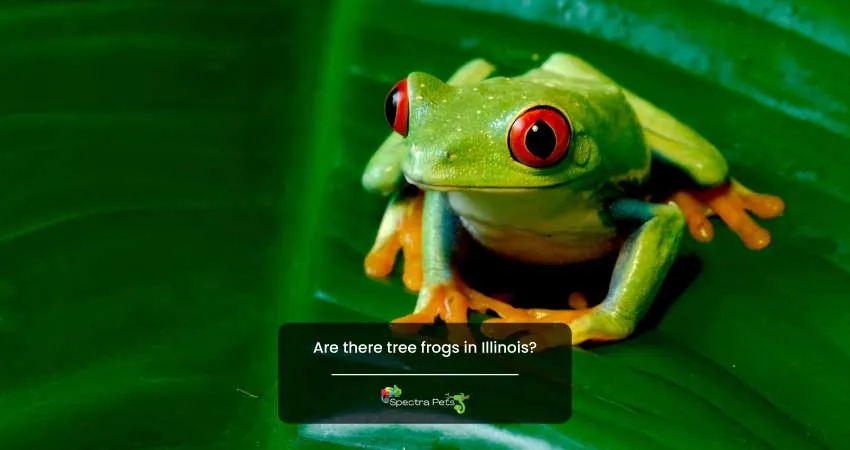
Illinois is home to a lot of tree frogs. The region has a bunch of different variants. To be specific, there are 7 varieties of tree frogs living in Illinois.
If the weather’s nice, you can see tree frogs during the day in most parts of the state, even if they’re primarily creatures of the night.
What does an Illinois Tree Frog look like?

As mentioned before, there are 41 different species of amphibians living in Illinois. Not all of them are tree frogs, though. Most variants are prevalent in northern Illinois. So how do you recognize which of them are tree frogs? Good question.
Below is a list of tree frog subspecies found throughout Illinois:
- Bird-voiced Tree Frog
- Eastern Cricket Frog
- Gray Tree Frog
- Green Tree Frog
- Spring Peeper
- Western Chorus Frog
Bird-voiced Tree Frog
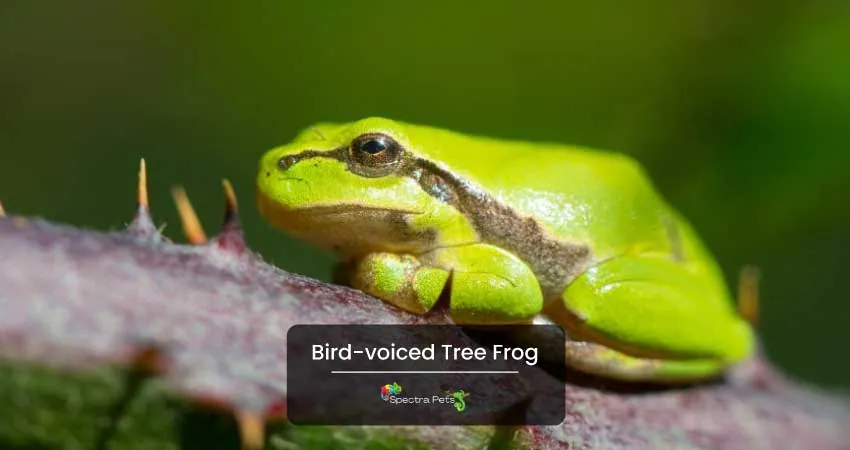
Family : Hylidae
Scientific Name : Hyla avivoca
Yes, you’ve heard it right, a tree frog that sounds like a bird! Sadly, they are an endangered species now. Thus, you rarely see them in Illinois. But if you’re lucky enough, who knows, you might see one.
A bird-voiced tree frog typically measures between 1 and 1.75 inches in length. You’ll notice that each of its eyes have a bright spot underneath it. The hidden areas of the hind legs range in color from a light yellow-green to a green or yellow-white. The color of the body is either gray, brown, or green. On the end of each toe is an adhesive pad. Another distinguishing feature is the long legs and narrow waist. The tadpole has a dark brown body, a red saddle with three to seven spots, and thin bronze stripes on its head.
The southern part of the state is home to the bird-voiced tree frog, which dwells in marshes, sloughs, and cypress swamps. This small frog frequently inhabits trees or shrubs. It breeds from mid-May into August. The female frogs deposit eggs in submerged packets in the water. Eggs take three to four days to hatch. In roughly one month, the metamorphosis takes place.
The Bird-Voiced Tree Frog consumes insects and other invertebrates.
A single bird-voiced tree frog makes 10 to 20 melodic beeps, and each of them lasts several seconds. The fascinating part about it is that these peeps will not only be in rapid succession but also vary in tempo, occasionally. This frog responds to aggressive interactions by emitting a harsh trill, “prrr eeeekkkk,” either singularly or repeatedly. The male’s call is a drawn-out, quavering note that sounds like a bird.
Eastern Cricket Frog
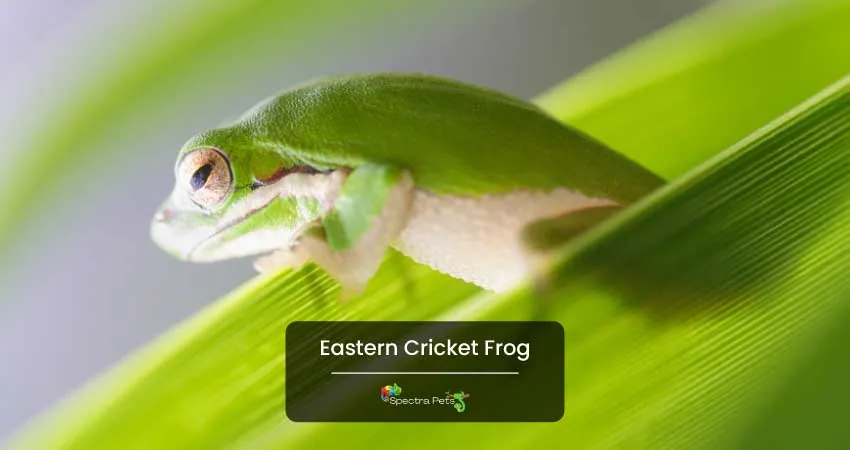
Family : Hylidae
Scientific Name : Acris crepitans
The Eastern Cricket Frog can be found throughout Illinois.
This frog typically grows to a length of 1/2 to 1-1/2 inches. Its body is gray, black, olive, tan, light brown, or black in color. Warts cover the skin. There is a dark triangle between the eyes. You’ll see dark stripes on the back of their thighs.
In each webbed foot, the toe ends are covered with a small adhesive pad. There are light bars on the nose and a light line running from each eye to each shoulder.
The eastern cricket frog makes its home along the margins of ponds, streams, and ditches. Despite belonging to the family of tree frogs, it does not live in trees. Normally active during the day, this frog may also be active at night during the summer.
Despite being tiny, this frog can survive the winter if the weather isn’t too harsh. This is due to them being relatively tolerant of the cold. For its size, it is capable of leaping extremely high.
Late April through the summer is the breeding season for cricket frogs. The female lays up to 400 eggs on the water’s surface, either one at a time or in tiny, filmy packets. The eggs develop into tadpoles with black-tipped tails a few days later. After hatching, metamorphosis takes place 5 to 10 weeks later.
Arthropods (such as spiders, mites, insects, and others) are the main source of food for the Eastern Cricket Frog. The male calls with a metallic “glick, glick, glick” that resembles two tiny rocks being struck against each other.
Gray Tree Frog
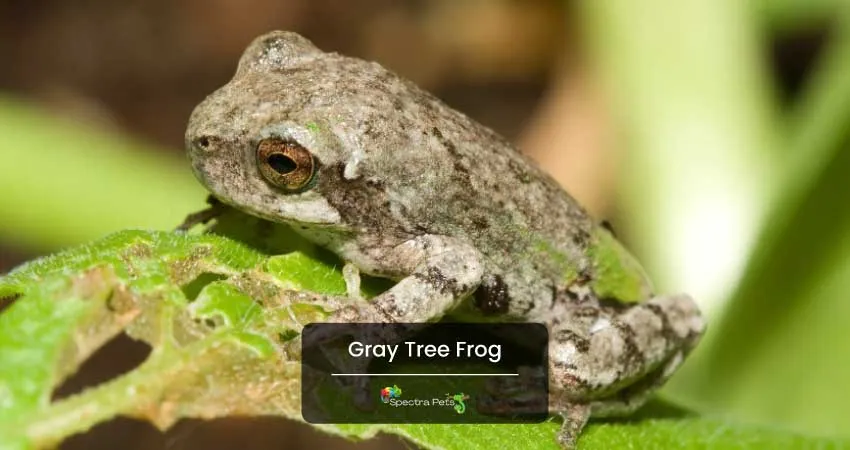
Family : Hylidae
Scientific Name : Hyla versicolor
The Gray Tree Frog and Cope’s Gray Tree Frog make up the Gray Tree Frog complex. The Gray Tree Frogs range in size from 1.25 to 2 inches. Despite being two different species, the Cope’s Gray Tree Frog and the Gray Tree Frog share a similar exterior appearance. But their calling is different.
Additionally, their chromosome counts vary. While Cope’s Gray Tree Frog is diploid, the Gray Tree Frog is tetraploid.
Although there are many variations, the body is typically gray or green. Each eye has a light spot underneath it. Bright orange and black flecks cover the undersides of the hind legs. The back is warty and has a star-shaped or erratic dark blotch. At the end of each toe is an adhesive pad. There are striking red and black markings on the tadpole’s tail.
Throughout the state, the gray tree frog can be found in wooded areas close to bodies of water. It can be discovered in shrubs and trees that are in or near water, in dry areas, in dead trees, under bark, or in rotten logs.
Breeding takes place from late April to early August. The females deposit eggs in almost any water-filled depression. The vegetation at the water’s surface is covered in packages of two to three dozen eggs. Each female may lay up to 1800 eggs. The eggs hatch in a short period of time. Larvae transform within two months of hatching. This usually occurs between March and May.
The gray tree frog consumes arthropods such as spiders, insects, mites, and others.
The Gray Tree Frogs trill call has between 17 and 35 pulses per second. The male’s call is a musical trill resembling the red-bellied woodpecker’s call. This frog will react with aggressive squeaky chirps or yells when approached by another calling male.
These frogs can be heard singing from trees or shrubs during the summer.
Green Tree Frog
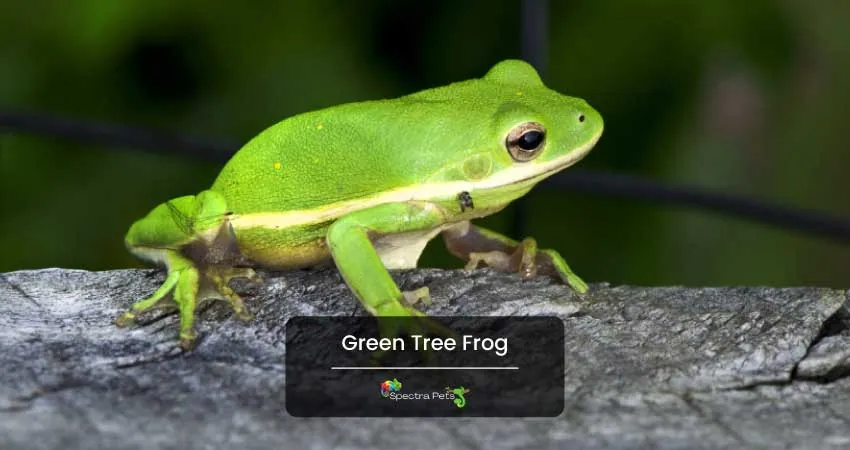
Family : Hylidae
Scientific Name : Hyla cinerea
The Green Tree Frog lives in swamps and marshes in the southern third of the state. It might be located on vegetation like cattails. This species breeds from the middle of May until August.
The Green Tree Frog is typically between 1.25 and 2.25 inches long. Normally, it has a vivid green body color. There is a white or yellowish stripe on each side. On the back, there might be a few tiny gold flecks. The skin texture is silky. Each toe has an adhesive pad at the end.
The females lay eggs on floating vegetation in the form of a film or tiny packet. Their egg count is between 500 and 1000. The eggs hatch in a short period of time. Approximately two months after hatching, they completely transform into land-based form.
This frog primarily consumes arthropods, such as insects, spiders, and mites.
The male makes the sound of a cowbell, “quonk, quonk, quonk,” in his call. This frog emits a loud, aggressive “quarr quarr quarr” that is repeated very quickly when it feels threatened. They are often audible when massive choruses break out after heavy rain.
Spring Peeper
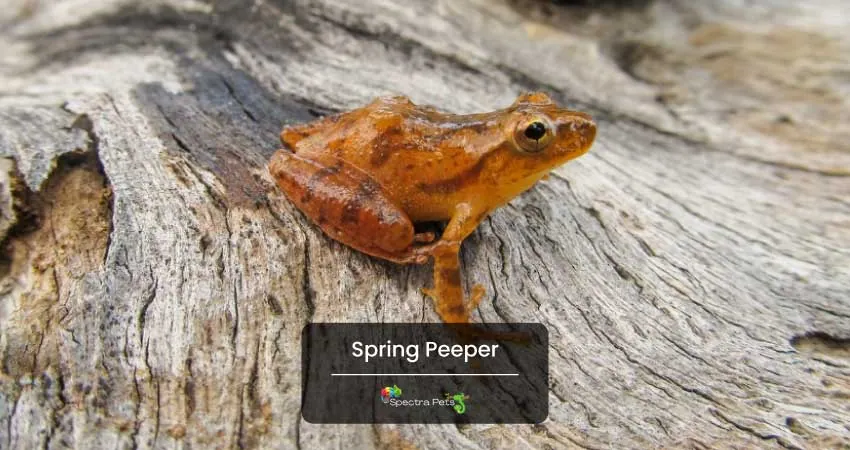
Family : Hylidae
Scientific Name : Pseudacris crucifer
The spring peeper typically measures 0.75 to 1.25 inches in length. It has a dark mark between the eyes and an erratic, “X”-shaped mark on the back. The body is a pinkish-tinged shade of yellow, brown, gray, or olive. The tips of each toe have a small adhesive pad.
You can find the Spring Peeper in moist woodlands across the state. This frog is rarely seen, except during breeding season. It resides on herbaceous plants or in trees and usually operates at night.
Spring Peepers breed from early March to early June. A female lays several hundred eggs, each one attached to a submerged object. In a few days, the egg hatches, and in May and June, it fully develops into its land-based form.
These tiny amphibians eat small arthropods such as spiders, insects, and mites.
The male whistles softly, which resembles a bird. Males frequently alternate duets or trios of calls while perched in vegetation over water or on surface water. Distant choruses might resemble jingling sleigh bells. When confronted, this frog will make an aggressive call, which is a short, stuttering trill that ends with a typically rising pitch of “purrreeekkk.”
Additionally, this frog makes a “rain call,” which is harsher and more dissonant than its springtime advertisement calls, and is occasionally heard from trees and shrubs in the summer and fall.
Western Chorus Frog
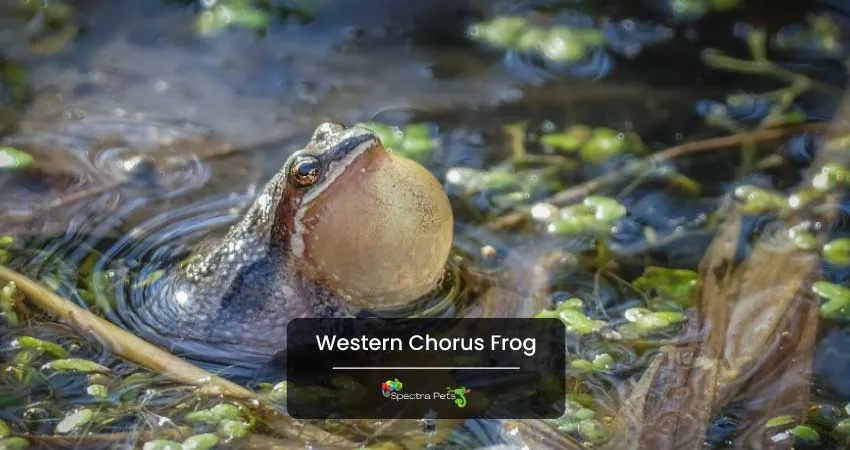
Family : Hylidae
Scientific Name : Pseudacris triseriata
The Western Chorus Frog is a threatened subspecies that can rarely be seen around Illinois. It can be found between Interstate 70 and Illinois Route 13 in Illinois.
These frogs measure 0.75 to 1.5 inches in length. There are three lengthy, dark stripes on the back. Across the eye, one dark stripe runs from the proboscis to the crotch. There could be a dark triangular mark in between both eyes. An extremely fine line runs over the top lip. Body colors for this frog include brown, gray, green, and olive.
The Western Chorus Frog lives in meadows, farmed fields, and the city. Once the mating season is over, it is hardly ever seen again.
It reproduces from March to May, frequently in interim ponds. The female lays up to 100 eggs, which are affixed to aquatic objects. In total, a single female can lay between 500 and 1,500 eggs. In a few days, eggs molt. The tadpoles go through a transformation in May and June.
The Western Chorus Frog’s diet includes small arthropods such as spiders, insects, and mites.
The male’s call is “creek” or “preep”. This can be imitated by running a finger across the teeth of a comb.
Are there poisonous tree frogs in Illinois?

All of the frogs in Illinois are non-venomous when handled, but tree frog skin secretions can sting if they come into contact with human eyes, noses, or mouths. Ingesting or mouthing a frog may cause nausea in pets.
Interesting facts about Tree Frogs

Frogs are able to survive in a wide range of habitats. Tree frogs usually build their habitats on trees, branches, and places with high and dense vegetation, although some prefer living near ponds, swamps, and marshes.
Tree frogs can ascend vertical surfaces like windows and tree trunks thanks to the sticky cup on the end of each toe. They can be found in branches that are more than 50 feet in the air!
Unlike most other creatures, tree frogs have an excellent ability to camouflage themselves, making them hard to find.
Summary
Illinois is a great place to capture diverse and stunning photos of tree frogs because it houses a wide variety of tree frog subspecies. If you ever go to Illinois for a visit, and you love wildlife photography, you will definitely have a fun time taking shots of all the different tree frogs seen throughout this state!
Tree Frogs Found in the Nearby States of Illinois:
